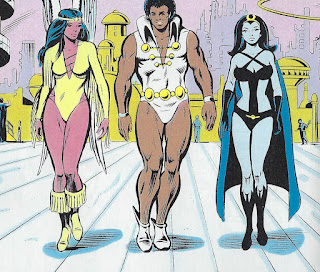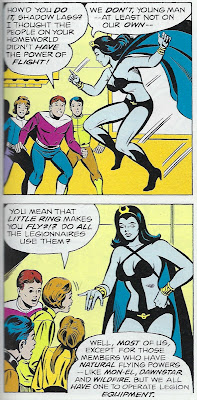Legion of Super-Heroes: Before the Darkness, Volume One
 |
|
Collection published: 2020 Contents originally published: 1979-81 Acquired: February 2021 Read: March 2023 |
Before the Darkness is DC's most recent reprint series for Legion of Super-Heroes, the one that finally totally seals the gap before The Great Darkness Saga, thus giving us a complete collection of the Legion from 1958 to 1984! I feel like this era is often spoken of in pretty disparaging terms, the consensus being that when Levitz and Giffen took over, they saved the book. Even in this very volume, the introduction comes across as an apology for what you are about to read, explaining that Gerry Conway—who writes most of the stories collected here—did not really like the Legion. Conway's run actually began with issues collected in the previous collection, Superboy and the Legion, Volume Two, and I didn't like much of what I read there.
So... I was pleasantly surprised by this run! I don't think Conway is among the great Legion writers, but this volume shows him to be among the solid ones. He provides more character focus than I remember from some previous Legion volumes, particularly on lesser-used, often-forgotten characters like Timber Wolf and Light Lass. Timber Wolf had largely faded into the background since he joined the Legion, but Conway gives him lots to do; Light Lass I don't remember doing anything at all ever, but here she's a versatile, integral member of the team. He shows off the powers of some other Legionnaires to good effect; Princess Projectra, always one of my favorites, got a couple excellent moments across these stories. We get a nice return to what Bouncing Boy and Duo Damsel are up to, for example. Maybe Conway didn't love the Legion, but he clearly threw himself into its history and characters with a gusto that he probably could have got away with not having.
Conway is also, I think, more of a science fiction fan than most comics writers: you can tell he was probably reading actual prose sf, not just reading other comics and watching bad films. He uses stuff like tachyons and explores how the President of Earth might be elected. Genuinely interesting worldbuilding, which is something that usually happens in Legion by accident... if at all. I particularly liked the climax of one story: the Legion, in space suits, grabs onto a spaceship when it enters hyperspace. Without a hull between hyperspace and them, their perceptions of its strange dimensions threaten to drive them mad, but Brainiac 5 has the bright idea that Projectra should cast an illusion of reality, so they all perceive themselves in a beautiful meadow. This includes the villain, who's there with them... and he, not understanding the illusion, runs away from them, thus letting go of the ship and losing himself in the depths of hyperspace.
 |
| Jim Sherman can balance the human and the cosmic alike. from Legion of Super-Heroes vol. 2 #262 (script by Gerry Conway, art by Jim Sherman) |
A lot of them are goofy, of course. Not sure what was up with the one about the guy who attacked the Legion with fake pirates! But every story by Conway has at least one solid moment of characterization, one clever twist. I particularly liked the saga of the "Dark Man."
Conway also writes out Tyroc but tries to smooth out his history in the process. When originally introduced, it seemed as though Tyroc came from an island where all humans of African descent were segregated to—and ignored. This story establishes something very different, that it's a Brigadoonesque place that only appears every two centuries, and that it was settled by escaped slaves from the 1800s. I guess this is better? Unfortunately, it writes Tyroc out, so he never gets a chance to make much of an impact as a character.
 |
| In the future, no one will wear pants. from Legion of Super-Heroes vol. 2 #265 (plot by Gerry Conway, script by J. M. DeMatteis, art by Jim Janes & Dave Hunt) |
Outside of Conway's stuff, there's a pretty bad fill-in by J. M. DeMatteis, which spends more time on overcomplicated exposition of the villain's backstory than the actual story, and three issues of Secrets of the Legion of Super-Heroes. This miniseries, written by Paul Kupperberg from a plot by E. Nelson Bridwell, with art by Jim Janes and Frank Chiaramonte, was I believe the first official attempt to put this history of the Legion into some kind of detailed order. With the way I dance around Legion history out of sequence, it's hard for me to know for certain, but I think this story is the source of many retcons we now take for granted.
The plot is thin: R. J. Brande is dying and his assistant Marla Latham sneaks into Legion H.Q. to steal files on the Legionnaires because he thinks one might secretly be related to him and thus be able to provide a blood transfusion. Like, why not just ask? But it's an excuse to watch some history tapes and for the Legion to reexplain their own backstories, and I appreciated that more than the mediocre attempt at drama. It's also the story that reveals Brande is secretly a Durlan and the father of Chameleon Boy.
 |
| Not really clear to me why the villain changed Dreamy into this outfit to murder her, to be honest. from Legion of Super-Heroes vol. 2 #268 (script by J. M. DeMatteis, art by Steve Ditko & Bob Wiacek) |
The art in this volume is generally quite solid, too. One story by Jim Sherman, which is always nice, but most of it is by the new-to-me Jim Janes, who I would say is above-average for the era is terms of doing character work with the art. I see he continues on into the next volume, but apparently has not done much other comics work, alas. I feel like he could have blossomed into quite a talent given time. Steve Ditko does one issue, and unlike most Legion artists, he gives the Legionnaires spacesuits, not just bubble helmets. But the spacesuits are colored to look like their costumes, which means any Legionnaire with bare arms or legs (which is most of the women and many of the men) has a spacesuit that is mostly flesh-colored. (I guess this could be the colorist's fault. On the other hand, the colorist was clearly told during some issues to make the outfits more modest, as parts of characters like Shadow Lass and Princess Projectra that are usually colored like skin are made to be part of their outfits.)
I read a Legion of Super-Heroes collection every six months. Next up in sequence: Before the Darkness, Volume Two



No comments:
Post a Comment